
40 Wall Street is a 927-foot-tall (283 m) neo-Gothic skyscraper on Wall Street between Nassau and William streets in the Financial District of Manhattan in New York City, New York. Erected in 1929–1930 as the headquarters of the Manhattan Company, the building was designed by H. Craig Severance with Yasuo Matsui and Shreve & Lamb. The building is a New York City designated landmark and is listed on the National Register of Historic Places (NRHP); it is also a contributing property to the Wall Street Historic District, an NRHP district.
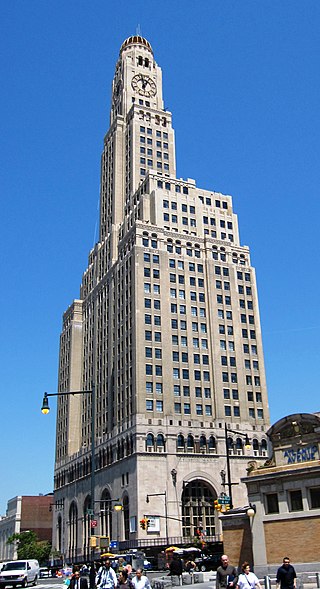
The Williamsburgh Savings Bank Tower, also known as One Hanson Place, is a skyscraper in the Fort Greene neighborhood of Brooklyn in New York City, New York. Located at the northeast corner of Ashland Place and Hanson Place near Downtown Brooklyn, the tower was designed by Halsey, McCormack & Helmer and constructed from 1927 to 1929 as the new headquarters for the Williamsburgh Savings Bank. At 41 stories and 512 feet (156 m) tall, the Williamsburgh Savings Bank Tower was the tallest building in Brooklyn until 2009.

The San Francisco Ferry Building is a terminal for ferries that travel across the San Francisco Bay, a food hall and an office building. It is located on The Embarcadero in San Francisco, California and is served by Golden Gate Ferry and San Francisco Bay Ferry routes.

The Jefferson Market Branch of the New York Public Library, once known as the Jefferson Market Courthouse, is a National Historic Landmark located at 425 Avenue of the Americas, on the southwest corner of West 10th Street, in Greenwich Village, Manhattan, New York City, on a triangular plot formed by Greenwich Avenue and West 10th Street. It was originally built as the Third Judicial District Courthouse from 1874 to 1877, and was designed by architect Frederick Clarke Withers of the firm of Vaux and Withers.

Downtown Long Beach, California, United States is the location for most of the city's major tourist attractions, municipal services and for numerous businesses. There are many hotels and restaurants in the area that serve locals, tourists, and convention visitors.

The Eastern Columbia Building, also known as the Eastern Columbia Lofts, is a thirteen-story Art Deco building designed by Claud Beelman located at 849 S. Broadway in the Broadway Theater District of Downtown Los Angeles. It opened on September 12, 1930, after just nine months of construction. It was built at a cost of $1.25 million as the new headquarters and 39th store for the Eastern-Columbia Department Store, whose component Eastern and Columbia stores were founded by Adolph Sieroty and family. At the time of construction, the City of Los Angeles enforced a height limit of 150 feet (46 m), however the decorative clock tower was granted an exemption, allowing the clock a total height of 264 feet (80 m). J. V. McNeil Company was the general contractor.

The Mercantile National Bank Building is a 31-story, 159.4 m (523 ft) skyscraper at 1800 Main Street in the Main Street district of downtown Dallas, Texas. It is the former home of the Mercantile National Bank, which later became MCorp Bank. The design of the skyscraper features Moderne styling from the Art Deco era and was designed by Walter W. Ahlschlager. The building has a series of setbacks that is crowned by an ornamental four-sided clock along with a decorative weather spire. The Merc was the main element of a four-building complex that eventually spanned a full city block.
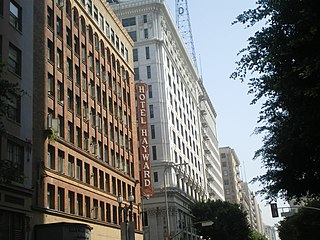
Spring Street in Los Angeles is one of the oldest streets in the city. Along Spring Street in Downtown Los Angeles, from just north of Fourth Street to just south of Seventh Street is the NRHP-listed Spring Street Financial District, nicknamed Wall Street of the West, lined with Beaux Arts buildings and currently experiencing gentrification. This section forms part of the Historic Core district of Downtown, together with portions of Hill, Broadway, Main and Los Angeles streets.
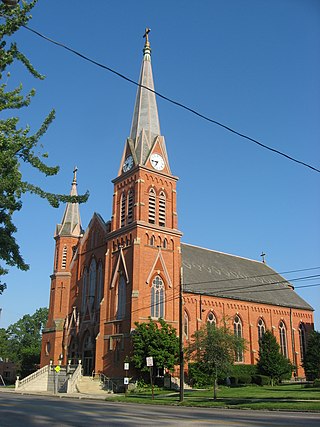
St. Mary's Catholic Church is a historic Catholic parish church in the city of Delaware, Ohio, United States. Constructed in the 1880s, this grand building is home to a congregation established in the middle of the nineteenth century. Its grand style has long made it a community landmark, and it was named a historic landmark in 1980.
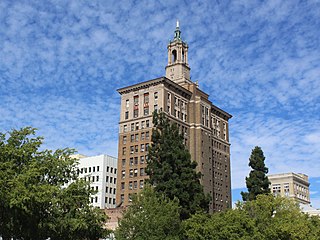
The Bank of Italy Building is a 14-story, 77.72 m (255.0 ft) Renaissance Revival high-rise office building on the corner of South First Street and Santa Clara Street in downtown San Jose, California. Built in 1925–26 as San Jose's first skyscraper, it has a red-tile hip roof and a decorative cupola with a needle-like spire featuring a tall green light. It is a designated San Jose Historical Landmark and part of the Downtown Historic District.

Walker & Eisen (1919−1941) was an architectural partnership of architects Albert R. Walker and Percy A. Eisen in Los Angeles, California.

Morgan, Walls & Clements was an architectural firm based in Los Angeles, California and was responsible for many of the city's landmarks, dating back to the late 19th century.

The Colman Building is a historic office building on First Avenue in downtown Seattle, Washington. It occupies a half of a block in proximity to Pioneer Square, and is bound by First Avenue, Marion, and Columbia Streets. It is listed on the National Register of Historic Places and is a City of Seattle landmark.
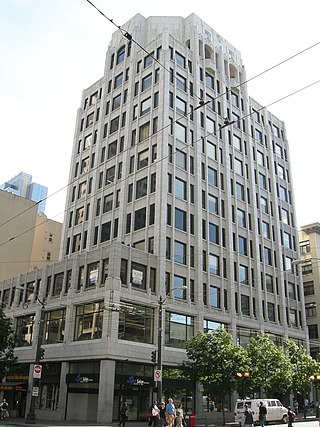
The Olympic Tower, originally known as the United Shopping Tower, then the Northwestern Mutual Insurance Building, and later, the Olympic Savings Tower, is a historic 12-story office tower located in Seattle, Washington and listed on the National Register of Historic Places. It was originally built in 1929 at the Southwest corner of Third Avenue and Pine Street for the United Pacific Corporation under the control of Seattle investment firm Drumheller, Ehrlichman and White. It was designed by Henry Bittman who also designed additions to the building in 1939.

The Schmidt Lithograph building, also known as the Clock Tower building and now Clocktower Lofts, is a former industrial building in the South Beach neighborhood of San Francisco, California, in the United States. Built in 1920–21 as part of the headquarters and printing plant of the Schmidt Lithograph Company, it is a contributing property in the South End Historic District. It was converted to condominiums in the early 1990s, with the address of 461 Second Street.

Sven is a residential building located at 29-59 Northern Boulevard in the Long Island City neighborhood of Queens, New York City. At 762 feet (232 m) tall, Sven is the third-tallest building in Queens behind Skyline Tower and The Orchard, as well as one of the tallest buildings in New York City outside of Manhattan.

Sohmer and Company Piano Factory is a historic piano factory located in the Astoria neighborhood of Queens, New York City. It was built in 1886 by Sohmer & Co., and is a six-story, L-shaped, Rundbogenstil / Romanesque Revival style brick building. The corner features a clock tower with a copper trimmed mansard roof. The building was expanded about 1906–1907. It was converted to residential usage starting in 2007.

The Norwood Tower is a historic commercial building in downtown Austin, Texas. Built in 1929, the tower was named a Recorded Texas Historic Landmark in 2006 and added to the National Register of Historic Places in 2011. At the time of construction, it was the city's tallest commercial structure and Austin's first fully air-conditioned office building, and the adjoining parking structure was the city's first self-parking ramped auto garage. The tower remains Austin's only Gothic Revival high-rise building.

The Wise Company was a department store in Long Beach, California founded in the early 1900s by W. H. ("Herb") Wise.

























